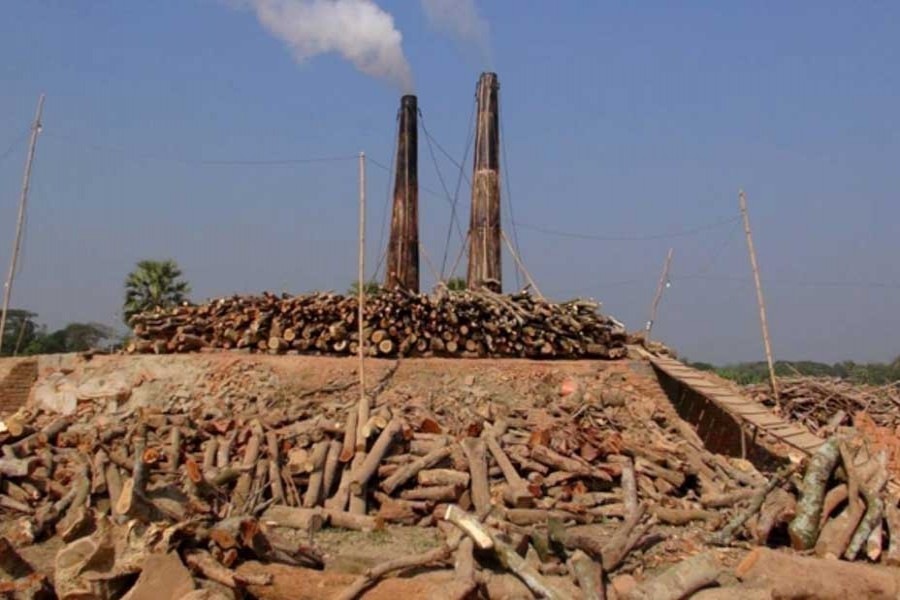Operation of illegal brick kilns in the country appears to be unstoppable. It is not just the media reports or the environmentalists' concern about the ruinous effects of these illegal structures that have failed to prevent the unabated misdeed but violatin of law stipulating the dos and don'ts in this regard is worrying enough to make one lose hope.
Recently, the High Court has issued a directive to the government to submit a list of unathorised brick kilns in and around Dhaka. Also, the HC has directed to close down all such illegal facilities in Dinajpur, Moulvibazar and the districts of Chottogram Hill tracks.
There is hardly any argument that among the many hazards affecting the environment, brick making is one that not only adversely affects the ecosystem but more significantly leaves a disastrous impact on a host of livelihood means of the masses, notably among others, cultivation. This is particularly so when it comes to conventional brick making practices in the country for ages.
The government's enactment of brick making law a few years ago was thought to be a strong deterrent that in course of time would be able to rein in the practice. Sadly, this has not happened as yet.
Emergence of brick kilns irrespective of locations has been on the rise for decades, largely due to the absence of any enforceable rules. This is not to say there was no law governing brick making. The Brick Burning (control) Act 1989 had its inadequacies to dictate terms in the first place, and besides, the lacuna in the enforcement of some of the compliance issues made things worse. Consequently, the practice of setting up brick plants at any location of choice went unopposed.
The law currently in force apparently addresses the core issues associated with brick-making-meant chiefly to check widespread environment pollution as well as save arable land and forest. The law 'Brick Making and Brickfield Establishment (Control) Act 2013' has brought tough regulations for brick production that among others provides for trial of offences under the penal code. The stipulations envisaged in the law apply to all brick kilns in the country. The law prohibits establishment of brick kilns in residential, protected, commercial and agricultural locations, and also in forests, sanctuaries, wetlands and ecologically critical areas.
According to the Department of Environment (DoE), there are well over 6,000 brickfields in the country, of which around 3,000 are located in and around Dhaka. However, environmentalists claim the number to be higher. According to a UNDP estimate, Bangladesh produces some 8.66 billion bricks a year valued at $450 million-almost 1.0 per cent of the country's GDP. Despite the sizeable contribution of brick-making to the economy, one of the grim realities is that brick fields all over the country are getting increasingly invasive in grabbing the country's less than sufficient arable lands. More dangerous is the threat that comes in terms of affecting neighbourhood lands under cultivation because of the heat, caustic smoke and dust generated by the brickmaking plants. A local daily reports that over 6.4 million tonnes of carbon emissions are caused by the brick kilns annually.
As things are going unabated despite the law in force, it is clear that mere formulation of the law didn't help-although the law was highly necessary and it did take a lot of things to work on. If not enforced in the right spirit, a law is no more than expression of intent. The job, no doubt, is challenging given the vast swathes of land, mostly agricultural, occupied by brick-making plants. Disciplining these in line with the law is one thing, and setting up new plants is another. The law does not categorically mention relocation or phasing out of the outmoded plants from the prohibited areas. Experts feel there should have been clear guidelines in the law for setting up of new plants adopting green technology.
In addition to the law in force, the HC had time and again issued instructions in the past to shut down illegal brick kilns as a measure of improving the air quality of the adjacent areas as well as to better utilise arable lands in the proximity of the kiln sites. Apparently, these instructions were not heeded to. Now that the HC has come up with precise instructions, seeking list of errant kilns, some effective actions are likely to address the situation.
Concerned quarters emphasise the need for introducing modern green technology capable of taking care of the pollution aspect to a great extent. Some brick-making plants in the country have moved in that direction, and in view of the wide acceptance of the technology in many countries chiefly because of its emission-preventing device, Bangladesh should move in a concerted way to promote the same. It is highly imperative that the government gradually phased out the traditional kilns and provided necessary support by way of soft-term financing to encourage the green technology.


